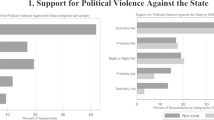Abstract
This article sets the stage for this special issue on political violence by providing some necessary background and definitions. For example, data plots are displayed to capture past and recent trends in transnational and domestic terrorist attacks, interstate and intrastate wars, and battle-related deaths. These plots document the changing nature of political violence in recent years. Additionally, this article indicates the basic themes of each study in this issue, along with their primary findings and methodologies. Special issue articles shed light on important aspects of terrorism, civil wars, coups, and piracy.




Similar content being viewed by others
Notes
See Shughart (2006) for a historical perspective of terrorism starting in 1945. This interesting article adopts a constitutional political economy perspective and separates terrorism into three waves: national liberation and ethnic separatism; left-wing; and Islamist terrorism.
Some of this escalation is an artifact of the Global Terrorism Database, which applied new coding procedures in recent years that identify more events as terrorism.
References
Arvanitidas, P., Economou, A., & Kollias, C. (2016). Terrorism’s effects on social capital in European countries. Public Choice, 169(3–4), 1–20. doi:10.1007/s11127-016-0370-3.
Bandyopadhyay, S., Sandler, T., & Younas, J. (2011). Foreign aid as counterterrorism policy. Oxford Economic Papers, 63(3), 423–447.
Bandyopadhyay, S., Sandler, T., & Younas, J. (2014). Foreign direct investment, aid, and terrorism. Oxford Economic Papers, 66(1), 25–50.
Berrebi, C., & Yonah, H. (2016). Terrorism and philanthropy: The effect of terror attacks on the scope of giving by individuals and households. Public Choice, 169(3–4), 1–24. doi:10.1007/s11127-016-0375-y.
Bezerra, P., & Braithwaite, A. (2016). Locating foreign aid commitments in response to political violence. Public Choice, 169(3–4). doi:10.1007/s11127-016-0377-9.
Daxecker, U. E., & Prins, B. C. (2016). The politicization of crime: Electoral competition and the supply of maritime piracy in Indonesia. Public Choice, 169(3–4), 1–19. doi:10.1007/s11127-016-0374-z.
Echevarria, J., & Gardeazabal, J. (2016). Refugee gravitation. Public Choice, 169(3–4), 1–24. doi:10.1007/s11127-016-0367-y.
Enders, W., Hoover, G. A., & Sandler, T. (2016). The changing nonlinear relationship between income and terrorism. Journal of Conflict Resolution, 60(2), 195–225.
Enders, W., & Sandler, T. (1991). Causality between transnational terrorism and tourism: The case of Spain. Terrorism, 14(1), 49–58.
Enders, W., & Sandler, T. (1999). Transnational terrorism in the Post-Cold War era. International Studies Quarterly, 43(2), 145–167.
Enders, W., & Sandler, T. (2002). Patterns of transnational terrorism, 1970–1999: Alternative time-series estimates. International Studies Quarterly, 46(1), 145–165.
Enders, W., & Sandler, T. (2012). The political economy of terrorism (2nd ed.). New York: Cambridge University Press.
Enders, W., Sandler, T., & Gaibulloev, K. (2011). Domestic versus transnational terrorism: Data, decomposition, and dynamics. Journal of Peace Research, 48(3), 319–337.
Enders, W., Sandler, T., & Parise, G. F. (1992). An econometric analysis of the impact of terrorism on tourism. Kyklos, 45(4), 531–554.
Findley, M. G., & Young, J. K. (2012). Terrorism and civil war: A spatial and temporal approach to a conceptual problem. Perspectives on Politics, 10(2), 285–305.
Gaibulloev, K., Piazza, J. A., & Sandler, T. (2016). Regime types and terrorism. Unpublished manuscript, Center for Global Collective Action, University of Texas at Dallas, Richardson, TX.
Gaibulloev, K., & Sandler, T. (2016). Decentralization, institutions, and maritime piracy. Public Choice, 169(3–4), 1–18. doi:10.1007/s11127-016-0346-3.
Gaibulloev, K., & Younas, J. (2016). Conflicts and domestic bank lending. Public Choice, 169(3–4), 1–17. doi:10.1007/s11127-016-0362-3.
Gassebner, M., Gutmann, J., & Voigt, S. (2016). When to expect a coup d’état? An extreme bounds analysis of coup determinants. Public Choice, 169(3–4), 1–21. doi:10.1007/s11127-016-0365-0.
Gleditsch, K. S., & Polo, S. M. T. (2016). Ethnic inclusion, democracy, and terrorism. Public Choice, 169(3–4), 1–23. doi:10.1007/s11127-016-0360-5.
Mickolus, E. F., Sandler, T., Murdock, J. M., & Flemming, P. (2016). International terrorism: Attributes of terrorist events, 1968–2015 (ITERATE). Ponte Vedra, FL: Vinyard Software.
National Consortium for the Study of Terrorism and Responses to Terrorism (START). (2016). Global terrorism database. Retrieved July 1, 2016, from www.start.umd.edu/gtd/.
Neumayer, E., & Plümper, T. (2016). Spatial spill-overs from terrorism on tourism: Western victims in Islamic destination countries. Public Choice, 169(3–4), 1–12. doi:10.1007/s11127-016-0359-y.
Piazza, J. A. (2016). Oil and terrorism: An investigation of mediators. Public Choice, 169(3–4), 1–18. doi:10.1007/s11127-016-0357-0.
Sambanis, N. (2004). What is a civil war? Conceptual and empirical complexities of an operational definition. Journal of Conflict Resolution, 48(6), 814–858.
Sambanis, N. (2008). Terrorism and civil war. In P. Keefer & N. Loayza (Eds.), Terrorism, economic development, and political openness (pp. 174–206). New York: Cambridge University Press.
Sandler, T. (2014). The analytical study of terrorism: Taking stock. Journal of Peace Research, 51(2), 257–271.
Sandler, T., & Hartley, K. (1995). The economics of defense. Cambridge: Cambridge University Press.
Shughart, W. F., II. (2006). An analytical history of terrorism, 1945–2000. Public Choice, 128(1–2), 7–39.
Uppsala Conflict Data Program (UCDP) (2016a). International Peace Research Institute (PRIO) armed conflict dataset, Version v.4–2015. Retrieved July 27, 2016, from http://www.pcr.uu.se/research/ucdp/datasets/ucdp_prio_armed_conflict_dataset/.
Uppsala Conflict Data Program (UCDP) (2016b). UCDP battle-related deaths dataset, Version v.5–2015. Retrieved July 27, 2016, from http://www.pcr.uu.se/research/ucdp/datasets/ucdp_battle-related_deaths_dataset/.
Acknowledgments
Special thanks are due to William F. Shughart II, who provided content and editorial assistance on all articles of this special issue. Khusrav Gaibulloev and William F. Shughart II provided helpful advice on this introduction. Justin George generated the four figures in the article.
Author information
Authors and Affiliations
Corresponding author
Rights and permissions
About this article
Cite this article
Sandler, T. Political violence: an introduction. Public Choice 169, 161–170 (2016). https://doi.org/10.1007/s11127-016-0380-1
Received:
Accepted:
Published:
Issue Date:
DOI: https://doi.org/10.1007/s11127-016-0380-1



